Christopher Sprigman's Blog, page 12
September 7, 2012
The Knockoff Economy on Canadian TV
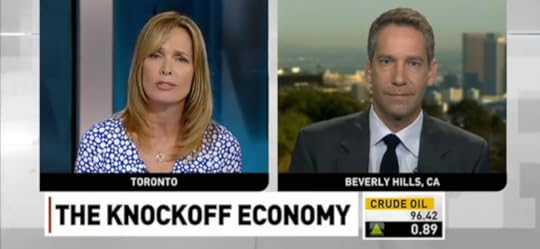 The Knockoff Economy on the Canadian TV! Kal takes a turn on the CBC’s business show, The Lang & O’Leary Exchange. Kal’s interview starts at 47:44.
The Knockoff Economy on the Canadian TV! Kal takes a turn on the CBC’s business show, The Lang & O’Leary Exchange. Kal’s interview starts at 47:44.
Free download of the introduction to The Knockoff Economy
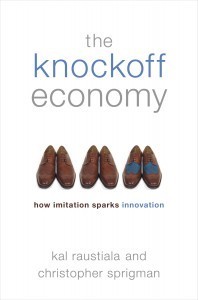 You can download the intro here. We hope you like it, and that you will want to read the whole thing — which you can find by clicking here!
You can download the intro here. We hope you like it, and that you will want to read the whole thing — which you can find by clicking here!
September 6, 2012
Federal appeals court in NYC says Yves Saint Laurent free to sell red shoes
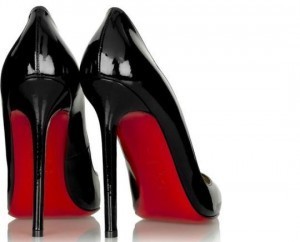 A federal appeals court in NY has handed down its ruling in the long-running litigation pitting red-soled women’s footwear impresario Christian Louboutin against fashion titan Yves Saint Laurent. Louboutin had sued Saint Laurent, claiming that the YSL’s all-red women’s pumps (see pic at top left) infringed Louboutin’s trademark in women’s
A federal appeals court in NY has handed down its ruling in the long-running litigation pitting red-soled women’s footwear impresario Christian Louboutin against fashion titan Yves Saint Laurent. Louboutin had sued Saint Laurent, claiming that the YSL’s all-red women’s pumps (see pic at top left) infringed Louboutin’s trademark in women’s 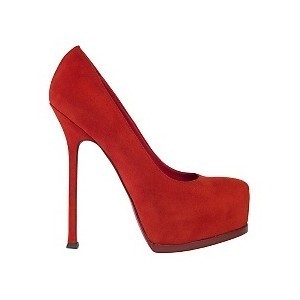 shoes bearing red outsoles. The NY court upheld a district court ruling in favor of YSL, albeit on narrower grounds. The court held that although Louboutin’s red sole is distinctive, and functions as a trademark, YSL had not violated it. Why? Because Louboutin’s red sole only functions as a mark on shoes with uppers of a contrasting color (because it’s only against a contrasting upper that you recognize the red sole as a mark), and YSL’s shoes (picture at left) were all red. YSL’s all-red shoe, in the court’s view, did not “use” Louboutin’s mark. Judgment for YSL.
shoes bearing red outsoles. The NY court upheld a district court ruling in favor of YSL, albeit on narrower grounds. The court held that although Louboutin’s red sole is distinctive, and functions as a trademark, YSL had not violated it. Why? Because Louboutin’s red sole only functions as a mark on shoes with uppers of a contrasting color (because it’s only against a contrasting upper that you recognize the red sole as a mark), and YSL’s shoes (picture at left) were all red. YSL’s all-red shoe, in the court’s view, did not “use” Louboutin’s mark. Judgment for YSL.
This seems right. But the NY court left unresolved what will happen if Louboutin sues another company making contrasting-color shoes with red soles. On the one hand, the court holds that Louboutin’s red soles function as a mark. But that does not settle the issue. The court left open the possibility that the red soles might be “aesthetically functional”. If they are, they cannot be protected even if consumers do believe that red-soled shoes come from Louboutin. We shall see . . .
ADDENDUM: For a more detailed breakdown of the opinion, see Rebecca Tushnet’s excellent post.
September 5, 2012
The Knockoff Economy on Freakonomics

Photo credit: Therese C
We have another excerpt from The Knockoff Economy up on the Freakonomics blog. This time, we’re writing about how knockoffs can actually help strengthen the brands they imitate.
The Knockoff Economy at Zocalo Public Square
Here’s the listing:
MONDAY, SEPTEMBER 10, 2012, 7:30 PM PT
Does Imitation Breed Innovation?
Kal Raustiala
[image error]
make a reservation
Goethe-Institut Los Angeles
5750 Wilshire Boulevard, Los Angeles, CA
Located in the Wilshire Courtyard Campus, kitty corner from the La Brea Tar Pits. Enter on Wilshire at Courtyard Place, one block east of Curson. Free parking on site after 6 pm.
Books will be available through Skylight Books.
Stop being mad that someone stole your idea or design or secret formula. UCLA legal scholar Kal Raustiala says things will work out well for you anyway. For one thing, those who come first do best. For another, informal policing helps keep things under control. But perhaps most importantly, imitation spurs innovation. Whether your business is food or fonts or films, you’re probably benefiting more than you think from all those copycats out there—and they just might be making your entire industry more creative. Or are they? Is all the rampant piracy really good for us, or should we fear the decline of intellectual property? Raustiala, coauthor of The Knockoff Economy, visits Zócalo to make the case for the copycat economy. Just make sure to look for the genuine Zócalo label.
Thanks to our media sponsor
[image error]
September 4, 2012
The Knockoff Economy in the L.A. Times
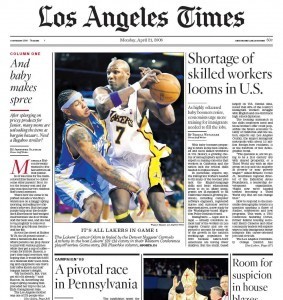 This morning Kal and I have an op-ed in the L.A. Times applying some of the lessons from The Knockoff Economy to the Apple/Samsung patent battle. Here’s a quick taste:
This morning Kal and I have an op-ed in the L.A. Times applying some of the lessons from The Knockoff Economy to the Apple/Samsung patent battle. Here’s a quick taste:
Apple, in designing the iPad and iPhone, created its version of a rectangular reading platform. Yet now Apple has succeeded in punishing Samsung for much the same thing: copying a rectangular design. And this highlights a central issue in today’s innovation-based economy. What is the proper balance between competition and copying?
Intellectual property law is based on the notion that copying is bad for creativity. It is usually cheaper to copy something than create something wholly new. If innovators are not protected against imitation, they will not invest in more innovation. At least that’s how the story goes.
The real world, however, tells a different story. Imitation is at the center of an enormous amount of innovation. Rules against copying are sometimes necessary. But in many cases, they serve to slow down innovation. Copying, in short, is often central to creativity.
September 2, 2012
The Knockoff Economy in Forbes
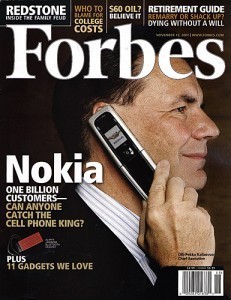 Kal does a Q&A for Forbes re: Apple/Samsung and how imitation can be good for innovation. Check out the Forbes cover at left — it’s from 2007, when Nokia was the king of the cellphone marketplace. Now the Finnish company is down to a single-digit market share in smartphones, although they are still a major player in the market for lower-end cellphones (dumbphones?). That Forbes cover shows that how fierce competition can be in technology markets, and how innovation can change the game in an instant. In any event, here’s Kal on the central irony of the Apple/Samsung fight — while Apple condemns Samsung as a copycat, Apple itself has a long and proud history of innovation through imitation:
Kal does a Q&A for Forbes re: Apple/Samsung and how imitation can be good for innovation. Check out the Forbes cover at left — it’s from 2007, when Nokia was the king of the cellphone marketplace. Now the Finnish company is down to a single-digit market share in smartphones, although they are still a major player in the market for lower-end cellphones (dumbphones?). That Forbes cover shows that how fierce competition can be in technology markets, and how innovation can change the game in an instant. In any event, here’s Kal on the central irony of the Apple/Samsung fight — while Apple condemns Samsung as a copycat, Apple itself has a long and proud history of innovation through imitation:
What’s most interesting about the verdict is that Apple itself is a serial imitator—as many great innovators are. Steve Jobs famously visited the Xeros Palo Alto Research Center in 1979, where he saw a Xerox prototype that used a mouse and a graphical user interface. Jobs adapted the ideas he saw at Xerox in what eventually became the Macintosh. And the rest is history.
In the current dispute, Samsung was surely imitating aspects of Apple’s designs. But so too was Apple imitating previous designs. The rectangular shape of the iPhone and iPad, for instance, strongly resemble the ur-reading device of paper. And there were many iterations between the invention of paper and the invention of the rectangular phone.
So while Samsung probably deserves some of the sweeping verdict, what Samsung did is really normal practice in many fields, including electronics. And it is a good thing, because it yields more competition.
Samsung wins one in Japan
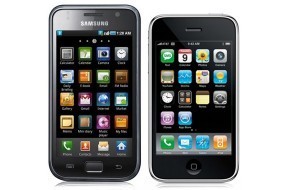 In the wake of its billion-dollar patent loss to Apple in federal court in California, Samsung has won a parallel court battle in Japan — and both are just preliminary skirmishes in what could turn out to be a protracted and world-wide Apple/Samsung patent war.
In the wake of its billion-dollar patent loss to Apple in federal court in California, Samsung has won a parallel court battle in Japan — and both are just preliminary skirmishes in what could turn out to be a protracted and world-wide Apple/Samsung patent war.
The Tokyo District Court ruled that Samsung’s Galaxy smartphones and tablets did not violate an Apple patent on technology that synchronizes music and videos between devices and servers. And a court in Korea recently issued a split decision that, on balance, favored Samsung. Nearly a dozen other cases are still grinding away, with perhaps many more to come.
So what does this all mean? Well, it’s too early to say how this is going to end, but here are a couple of early observations. First, the U.S. is the only jurisdiction in which patent claims are heard by juries. Everywhere else they are dealt with by judges. And it seems to us that judges, with their greater experience and perspective, are less likely to hand Apple the sort of outsized patent victory that the ten jurors in San Jose gave Apple with their billion-dollar verdict.
Second, and importantly, while these court cases are slowly proceeding, there is fierce competition out there in the marketplace between Apple and Google’s Android smartphone operating system, which runs on Samsung’s phones, as well HTC’s, LG’s, Motorola’s, and many others. And in the competition outside the courtroom Android is doing very well. Since 2008, when they first appeared, smartphones running Android have surged to a 68% worldwide market share. That’s 4 times greater than the iPhone’s 17% worldwide share. (Microsoft’s Windows mobile operating system and Nokia’s Symbian are each left with a paltry share of around 4%). Even in the U.S., where Apple is stronger than it is abroad, Android phones own over 50% of the market, with Apple trailing at about 35%.
We doubt that the litigation is going to change these competitive realities all that much. Which shows the limits of patents as the foundation of a business model, either in the smartphone space or anywhere else. Apple’s success in the marketplace depends more on its ability to rapidly and reliably introduce new and better versions of its iPhone. And if its worldwide patent battle distracts it even one bit from that job, it will lose far more momentum than any patent victory could ever give it.
August 31, 2012
Bikram Choudhury continues to press copyright claims in hot yoga routine
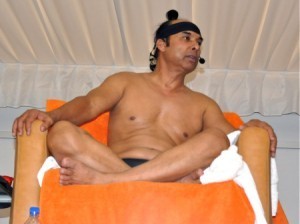 You have to hand it to Bikram Choudhury, the multimillionaire hot yoga impresario — the man has a lot of nerve. Choudhury has for years now been claiming a copyright in the particular sequence of yoga poses that his students (for reasons that escape us) choose to perform in stifling 105 degree heat. And he’s spent a lot of money on lawyers to sue yoga instructors — many of them Bikram’s former students — who dared to implement the same or a similar sequence of poses in their own studios.
You have to hand it to Bikram Choudhury, the multimillionaire hot yoga impresario — the man has a lot of nerve. Choudhury has for years now been claiming a copyright in the particular sequence of yoga poses that his students (for reasons that escape us) choose to perform in stifling 105 degree heat. And he’s spent a lot of money on lawyers to sue yoga instructors — many of them Bikram’s former students — who dared to implement the same or a similar sequence of poses in their own studios.
All of this despite the fact that Bikram’s copyright claims are, in a word, absurd. The yoga poses Bikram uses have been in the public domain for thousands of years, so there can be no copyright in those. Bikram instead says he owns a copyright in the particular sequence in which he’s arranged the poses. But that doesn’t work either. Bikram claims that the poses, when performed in his particular sequence at 105 degrees, convey a variety of health benefits, ranging from the alleviation of diabetes to multiple sclerosis and obesity. In other words, Bikram claims that the sequence of yoga poses is functional. Fine, but functional things are not copyrightable. Copyright is for art and literature — not medicine. If the form of yogic medicine claimed by Bikram is protectable by any form of IP, it’s patent. And to get a patent on his sequence of poses, Bikram would have to show the U.S. Patent and Trademark Office that it’s novel, non-obvious, and useful. The PTO grants a lot of bad patents, but this one is probably a sure bet to be rejected.
Back in July, the U.S. Copyright Office issued a policy document essentially repeating the analysis above, and stating that yoga poses and sequences are uncopyrightable. You might have thought that the Copyright Office ruling would spell the end for Bikram’s litigation campaign. But you would have been wrong. LAWeekly has just run a long article on Bikram, wherein he makes clear that he’s continuing to sue — apparently, the Copyright Office ruling hasn’t deterred him a bit.
Not to blow our own horn, but we predicted this:
[T]he Copyright Office’s policy statement should put a stop to Bikram’s antics. Mind you I said “should”, not “will”. Because although the Copyright Office has this one right, courts have been known to ignore them. And Bikram is, if nothing else, persistent.
And from Bikram’s perspective, continuing to threaten suit is a completely rational move. The last thing he wants is to face more competition. Copyright lawsuits are expensive, and Bikram is in a much better position than his smaller rivals to pay pricey lawyers. And if he plays his cards right, he can tie competitors up for years, making entry into the hot yoga market pretty unattractive.
The point here is that we really have two different copyright laws. Bikram doesn’t have a monopoly on hot yoga under the copyright rules that you find in the law books. But Bikram may well succeed in suing many of his competitors out of business using the copyright law as it actually functions out in the world. Like a lot of law, copyright works a lot better for people with money.
August 30, 2012
The Knockoff Economy on Vice Magazine’s “Motherboard” Blog
 We’re interviewed by Vice magazine’s tech blog, Motherboard, about the Apple/Samsung decision. Maybe they’ll invite us to some super-cool parties? One can hope.
We’re interviewed by Vice magazine’s tech blog, Motherboard, about the Apple/Samsung decision. Maybe they’ll invite us to some super-cool parties? One can hope.



